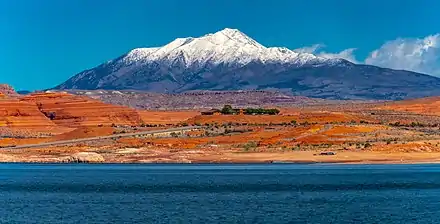Mount Pennell
Mount Pennell is a prominent 11,413-foot (3,478 m) elevation summit located in eastern Garfield County, Utah, United States.[3] Mount Pennell is the second-highest mountain in the Henry Mountains, following Mount Ellen, 10.6 miles to the north. It is situated in a dry, rugged, and sparsely settled region east of Capitol Reef National Park, on primitive land administered by the Bureau of Land Management. Several deep canyons cut the sides of the mountain, which on the higher slopes supports oak, Ponderosa pine, subalpine fir, spruce, Douglas fir, and aspen.[4] Precipitation runoff from this mountain drains into tributaries of the nearby Colorado River.
| Mount Pennell | |
|---|---|
 Mount Pennell, south aspect | |
| Highest point | |
| Elevation | 11,413 ft (3,479 m) [1] |
| Prominence | 3,568 ft (1,088 m) [1] |
| Parent peak | Mount Ellen (11,527 ft)[2] |
| Isolation | 10.62 mi (17.09 km) [2] |
| Coordinates | 37°57′24″N 110°47′27″W [3] |
| Naming | |
| Etymology | Joseph Pennell |
| Geography | |
 Mount Pennell Location in Utah  Mount Pennell Mount Pennell (the United States) | |
| Location | Garfield County, Utah, U.S. |
| Parent range | Henry Mountains |
| Topo map | USGS Mount Pennell |
| Geology | |
| Age of rock | Oligocene |
| Mountain type | Laccolith |
| Type of rock | Igneous |
| Climbing | |
| Easiest route | class 2 scrambling[2] |
History
This mountain was first called Un-chu'-ka-ret by the native Paiute.[5]
Almon Harris Thompson served as chief topographer and geographer of John Wesley Powell's Second Geographical Expedition (1871–1875) when he named Mount Ellen after his wife, Ellen Powell Thompson, and Mount Pennell was later named for his friend Joseph Pennell (1857–1926), an American artist and author.[6][7] Thompson also named Mount Hillers, seven miles to the southeast.[8] Through his work on the Powell expedition, and later as a geographer at the U.S. Geological Survey, Thompson was responsible for naming many geographical features in the Western United States.
The American geologist Grove Karl Gilbert surveyed this area in 1875 and 1876, and published his findings in 1879 as a monograph, The Geology of the Henry Mountains. The term laccolith was first applied as laccolite by Gilbert after his study of intrusions of diorite in the Henry Mountains.[9]
Climate
Spring and fall are the most favorable seasons to visit Mount Pennell. According to the Köppen climate classification system, it is located in a Cold semi-arid climate zone, which is defined by the coldest month having an average mean temperature below 32 °F (0 °C), and at least 50% of the total annual precipitation being received during the spring and summer. This desert climate receives less than 10 inches (250 millimeters) of annual rainfall, and snowfall is generally light during the winter.
References
- "Mount Pennell". Peakbagger.com. Retrieved 2020-09-12.
- "Pennell, Mount - 11,420' UT". listsofjohn.com. Retrieved 2020-09-12.
- "Mount Pennell". Geographic Names Information System. United States Geological Survey. Retrieved 2020-09-12.
- https://www.blm.gov/visit/mt-pennell
- Don D. Fowler and Catherine S. Fowler, Anthropology of the Numa, Smithsonian Institution Press, 1971, page 141.
- Don D. Fowler and Catherine S. Fowler, Anthropology of the Numa, Smithsonian Institution Press, 1971, page 141.
- Pete Klocki and Tiffany Mapel, A Wild Redhead Tamed: A Brief History of the Colorado River and Lake Powell, 2009, page 85.
- https://gotbooks.miracosta.edu/gonp/3Dcanyons/html/escalante.htm
- Aber, James S. "Grove Karl Gilbert". academic.emporia.edu. Retrieved 29 December 2018.
External links
- Weather forecast: Mount Pennell
